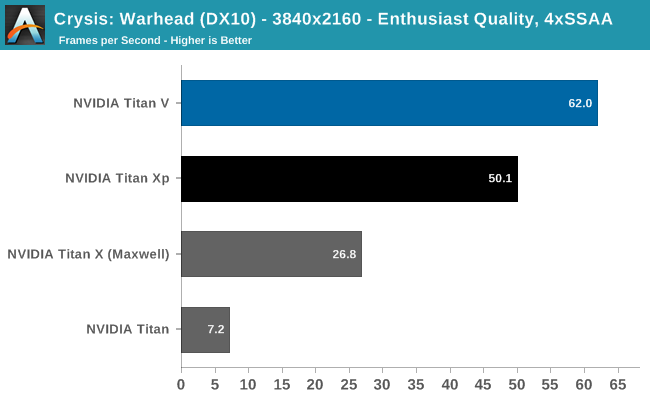The NVIDIA Titan V Preview - Titanomachy: War of the Titans
by Ryan Smith & Nate Oh on December 20, 2017 11:30 AM ESTBut Can It Run Crysis?
Even if the Titan V isn't a major leap in gaming performance, we couldn't help ourselves. We have a Titan, we have Crysis. The ultimate question must be answered. Can it run Crysis?

Yes, it can run Crysis.
And in fact, it is the only Titan that can reach the coveted 60fps mark. Perhaps Titan V is the card that can finally run Crysis the way it's meant to be played: maximum resolution, maximum details, and maximum anti-aliasing. At the end of the day, only one Titan stands above the rest when it comes to Crytek's testament to graphical intensity.










111 Comments
View All Comments
CiccioB - Thursday, December 21, 2017 - link
Absolute boost frequency is meaningless as we have already seen that those values are not respected anywhere with the use of boost 3.0. You can be higher or lower.What is important is the power draw and the temperatures. These are the limiting factors to reach and sustain the boost frequency and beyond.
With a 800+mm^2 die and 21 billions of transistor you may expect that the consumption is not that low as for a 14 billion die, and the frequencies cannot be sustained that much.
What is promising is that if these are the power drain of such a monster chip, the consumer grade chips made on the same PP will really be fresh and that the frequencies can be pushed really high to suck all the thermal and power drain gap.
Just imagine a Volta/Ampere GP104 consuming 300+W, same as the new Vega GPU based custom cards.
#poorVega
croc - Wednesday, December 20, 2017 - link
I can't take a titan-as-compute seriously if its double precision is disabled That, to me, makes it only aimed at graphics Yet this whole article is expressing the whole titan family as 'compute machines'...MrSpadge - Thursday, December 21, 2017 - link
It has all compute capability enabled: FP16, FP32, FP64 and the tensor cores. The double speed FP16 is just not (yet?) exposed to graphics applications.CiccioB - Thursday, December 21, 2017 - link
In fact this one has 1/2 FP64 computing capacity with respect to FP32.At least read the first chapter of the review before commenting.
mode_13h - Wednesday, December 27, 2017 - link
The original Titan/Black/Z and this Titan V have uncrippled fp64. It's only the middle two generations - Titan X and Titan Xp - that use consumer GPUs with a fraction of the fp64 units.Zoolook13 - Thursday, December 21, 2017 - link
The figure for tensor operations seems fishy, it's not based on tf.complex128 I guess more probably tf.uint8 or tf.int8 and then it's no longer FLOPS, maybe TOPS?I hope you take a look at that when you flesh out the tensorflow part.
If they can do 110 TFLOPS of tf.float16, then it's very impressive but I doubt that.
Ryan Smith - Thursday, December 21, 2017 - link
It's float 16. Specifically, CUDA_R_16F.http://docs.nvidia.com/cuda/cublas/index.html#cubl...
CheapSushi - Thursday, December 21, 2017 - link
Would be amazing if tensor core support was incorporated into game AI and also OS AI assistants, like Cortana.edzieba - Thursday, December 21, 2017 - link
"Each SM is, in turn, contains 64 FP32 CUDA cores, 64 INT32 CUDA cores, 32 FP64 CUDA cores, 8 tensor cores, and a significant quantity of cache at various levels."IIRC, the '64 FP32 cores' and '32 FP64 cores' are one and the same: the FP64 cores can operate as a pair of FP32 cores (same as GP100 can do two FP16 operations with the FP32 cores).
Ryan Smith - Thursday, December 21, 2017 - link
According to NVIDIA, the FP64 CUDA cores are distinct silicon. They are not the FP32 cores.